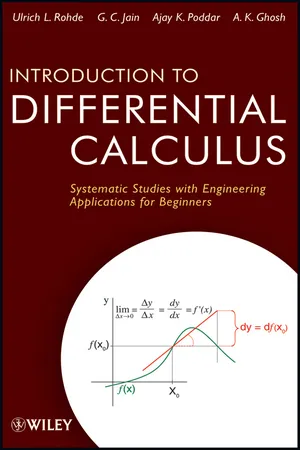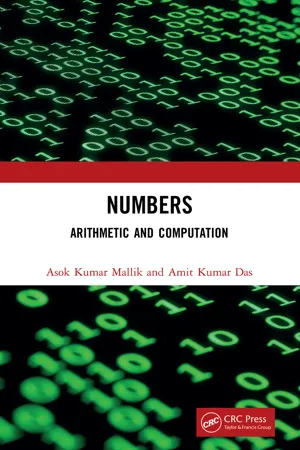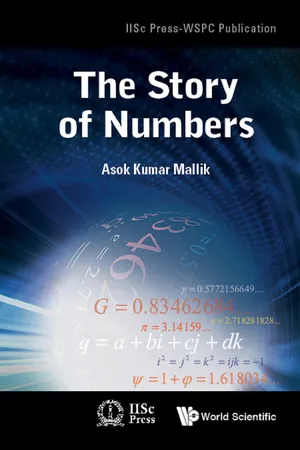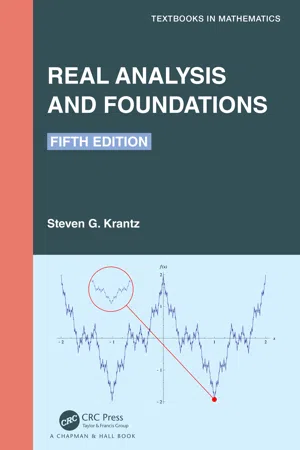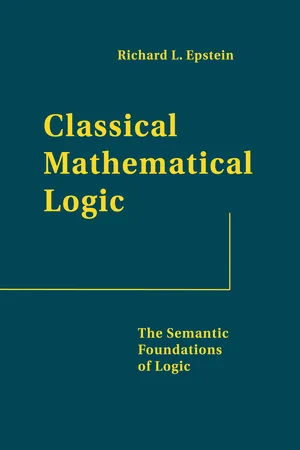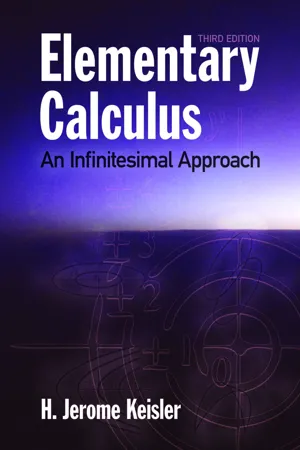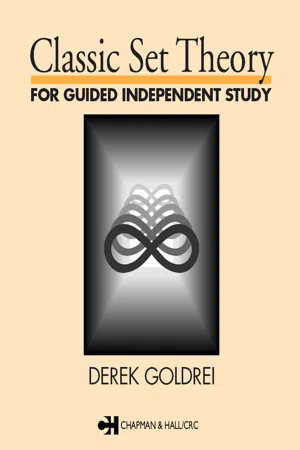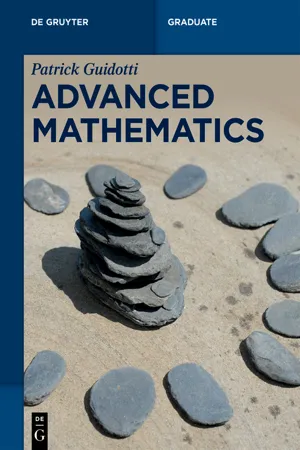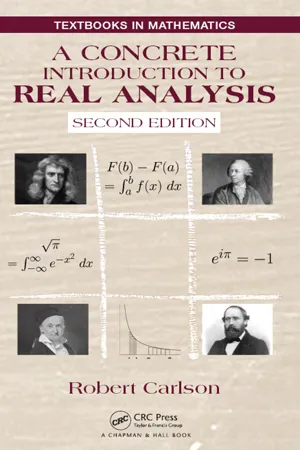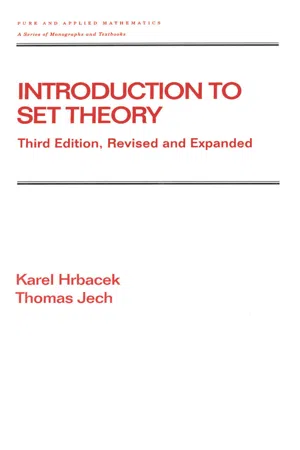Mathematics
Real Numbers
Real numbers are the set of all rational and irrational numbers, including integers and fractions. They can be represented on the number line and are used to quantify continuous quantities such as length, area, volume, and time. Real numbers are essential in various mathematical operations and are fundamental in many branches of mathematics, including algebra, calculus, and geometry.
Written by Perlego with AI-assistance
Related key terms
Related key terms
1 of 4
Related key terms
1 of 3
12 Key excerpts on "Real Numbers"
- eBook - ePub
Introduction to Differential Calculus
Systematic Studies with Engineering Applications for Beginners
- Ulrich L. Rohde, G. C. Jain, Ajay K. Poddar, A. K. Ghosh(Authors)
- 2012(Publication Date)
- Wiley(Publisher)
. . ., and so on are irrational numbers.π and e (e = 2.7182818284 . . .) are special types of irrational numbers (called transcendental numbers ), which arise naturally in geometry and calculus, respectively.3.5 The Set of Real NumbersThe set of rational numbers together with the set of irrational numbers forms the set of Real Numbers denoted by R . Thus, .Now, we define a real number. 3.6 Definition of a Real NumberA real number is one that can be written as an unending decimal, positive or negative or zero.43.7 Geometrical Picture of Real NumbersWe use the term real line very frequently without any explanation, and of course what we mean by it is an ordinary geometric straight line whose points have been identified with the set R of Real Numbers.We use the letter R to denote the real line and the set of all Real Numbers . We say that, to every real number there corresponds a unique point on the number line, and conversely, to every point on the number line there corresponds a real number. It is due to this one-to-one correspondence that we often speak of Real Numbers as if they were points on the number line and we speak of the points on the real line as if they were Real Numbers. Yet, the fact remains that, a real number is an arithmetical object, whereas, a point is a geometric object.For the purpose of representing rational numbers by points on a straight line, we label any point on the line with “0” (zero) and any other point to the right of “0” with “1”. This fixes the scale . With this scale as unit length, we can easily plot on the number line all those points, which represent rational numbers. For this purpose we use the four fundamental operations of arithmetic (namely addition, subtraction, multiplication, and division). With regards to the irrational numbers, we have to go beyond these operations. - eBook - ePub
Numbers
Arithmetic and Computation
- Asok Kumar Mallik, Amit Kumar Das(Authors)
- 2022(Publication Date)
- CRC Press(Publisher)
Chapter 3 Real Numbers3.1 Introduction
In the last chapter we have seen the number line on which the integers are represented by discrete points with equal gap between two consecutive integers. The concept of number is then extended to fill up all these gaps with what is called real number continuum. In other words, all the points on the number line now represent numbers which are called Real Numbers. Thus, integers form a subset of the Real Numbers. The number line is now referred to as the real number line. In this chapter, we define, classify and discuss different representations of Real Numbers. Furthermore, besides discussing some curious patterns, we also point out surprising relationships between some numbers. Then we take up a few special Real Numbers. These special numbers are important universal constants which are frequently used in various branches of mathematics. Finally, it is shown how some special Real Numbers are used to describe various proportions and forms found in the self-made tapestry of nature.3.2 Rational numbers
We already mentioned that by dividing an integer by another we do not always get another integer. So we create another class of number, called rational number. A rational number R is defined using two integers, say p and q as(3.1)R =p qw i t h q ≠ 0Integers are included in the category of rational numbers with q = 1. Unless otherwise stated, we assume that p and q are co-primes, implying there is no common divisor (except trivial 1) between p and q. This fact can also be said as “the rational number has been expressed in its simplest or lowest form”. With q > p, we call the number a rational fraction, Rf , with(3.2)R f=p qw i t h q > pThe integer p is called the numerator and q the denominator of the fraction. A rational number R greater than 1 has an integer part I and a fractional part F(= Rf ), i.e.(3.3)R = I + FThe segment of the real number line between 0 and 1 cannot be filled up by only rational fractions. Similarly, any segment of the real number line cannot be filled up by only rational numbers. The gaps left in the real number line, after plotting all the infinite rational numbers, are filled up by another infinite set called irrational numbers. - eBook - ePub
- Asok Kumar Mallik(Author)
- 2017(Publication Date)
- World Scientific Publishing Company(Publisher)
Chapter 3
Real Numbers
In Figure 2.1 we have seen that integers indicated by discrete points on a line, called the number line, have gaps between them. The concept of numbers is extended to include all the points on the number line. All such numbers to be discussed in this chapter are called Real Numbers and the number line will be referred to as the real number line. The Real Numbers have two basic classifications, viz., rational and irrational. Just like reference [7] for prime numbers, a real number dictionary and online internet-based reference for special Real Numbers is also available.f3.1.Rational Numbers
Arithmetical operations like addition and multiplication on positive integers result in positive integers. It has already been mentioned that the process of subtraction of a larger integer from a smaller one necessitated the creation of negative integers. The first non-integers which were included to extend the concept of numbers are rational numbers. A rational number, r, is created by the process of division aswhere p and q are integers.If q > p, then we call the rational number, f, a rational fractiongFor p > q, the rational number r = I + f, where I is the integer part and f is the fractional part. Integers are also rational numbers with q = 1 and f = 0. If we consider the segment of the real number line between 0 and 1, then all the rational fractions, f, fail to cover all the points. Similarly, the segment between any two integers cannot be filled up using only rational numbers [9]. To fill up the real number line in a continuous manner, we need the irrational numbers also.3.2.Irrational Numbers
Euclid’s Elements contains a simple proof that is an irrational number. The number (if we agree to call it a number) cannot be expressed as a rational number. This can be proved by contradiction. Assuming this number to be rational, let it be expressed in its lowest form as , where p and q - eBook - ePub
- Steven G. Krantz(Author)
- 2022(Publication Date)
- Chapman and Hall/CRC(Publisher)
1 Real and Complex NumbersDOI: 10.1201/9781003222682-21.1 The Real Numbers
This is a book about analysis in the real number system. Such a study must be founded on a careful consideration of what the Real Numbers are and how they are constructed. In this section, we give a careful treatment of the real number system. In the next, we consider the complex numbers.We know from Real Numbers calculus that, for many purposes, the rational numbers are inadequate. It is important to work in a number system that is closed with respect to the operations we shall perform. This includes the limiting operations. While the rationals are closed under the usual arithmetic operations (addition, subtraction, multiplication, and division), they are not closed under the limits mathematical operation of taking limits. For instance, the sequence of rational numbers 3, 3.1, 3.14, 3.141, … consists of terms that seem to be getting closer and closer together, seem to tend to some limit, and yet there is no rational number that will serve as a limit (of course, it turns out that the limit is π—an “irrational” number).We will now deal with the real number system, a system that contains all limits of sequences of rational numbers (as well as all limits of sequences of Real Numbers!). In fact, our plan will be as follows: in this section, we shall discuss all the requisite properties of the reals. The actual construction of the reals is rather subtle, and we shall put that in an Appendix to Section 1.1 .Definition 1.1: Let A be an ordered set and X a subset of A . The set X is called bounded above if there is an elementb ∈ Asuch thatx ≤ bfor allx ∈ X. We call the element b an upper bound for the set X.Example 1.2: LetA = ℚ(the rational numbers) with the usual ordering. The setX = { x ∈ ℚ : 2 < x < 4 }is bounded above. For example, 15 is an upper bound for X. So are the numbers 12 and 4. It is interesting to observe that no element of this particular X can actually be an upper bound for X. The number 4 is a good candidate, but 4 is not an element of X. In fact, ifb ∈ X, then( b + 4 ) / 2 ∈ Xandb < ( b + 4 ) / 2, so b could not be an upper bound for X. □ - eBook - ePub
Classical Mathematical Logic
The Semantic Foundations of Logic
- Richard L. Epstein(Author)
- 2011(Publication Date)
- Princeton University Press(Publisher)
. The set of Real Numbers is taken to be the set of all Dedekind cuts. It's not hard to establish an ordering of the Real Numbers that has the properties we expect, but with this construction it is hard to establish the arithmetical properties of the reals.Since the rationals were considered unproblematic, the theory of the Real Numbers was thought to be put on a solid foundation. But these constructions, done in an informal theory of sets, were seen to require a new assumption not used in mathematics before: Infinite collections, such as , or infinite sequences had to be considered completed, not in the process of construction but a single unit. Formalizing or clarifying the assumptions on which those constructions were based was an important motive in the development of set theory. Nowadays the constructions are still done by mathematicians in an informal theory of sets. The two constructions are equivalent, in that an isomorphism of them relative to addition, multiplication, and the ordering can be given. So we have four ways to conceive of the Real Numbers:Points on a line.Characterized by their properties.Constructed: As sequences of rationals; as Dedekind cuts of rationals.We want to use classical mathematical logic to clarify the relations among these conceptions. We cannot answer the question of what the Real Numbers are, but we can show that the answers that have been proposed are in some sense equivalent.In this chapter I'll develop an axiomatic characterization of the Real Numbers. We could take the resulting axiomatization as all there is to the Real Numbers: Any set that satisfies the axiomatization has a right to be called ‘the Real Numbers’. But we need that there is at least one model of the axiomatization, so I give a construction of the reals via Dedekind cuts in an appendix to this chapter. In what follows, when I say that the real line has some property by construction I am referring to that. For the construction of the reals by sequences, see, for example, Mendelson, 1973. - eBook - ePub
Real Analysis
A Historical Approach
- Saul Stahl(Author)
- 2012(Publication Date)
- Wiley(Publisher)
Chapter 6 The Real NumbersThe remaining chapters of this book are dedicated to the task of replacing most of the previous unrigorous arguments with acceptable proofs. This calls for a careful reexamination of several fundamental concepts. This chapter contains basic information about the real number system, rational and irrational numbers, sets, and functions.6.1 AN INFORMAL INTRODUCTIONIt is both natural and customary to picture numbers on a horizontal straight line, the so-called number line . If the number r is represented by the point Pr , then this representation has two properties:If r < s then Pr falls to the left of P s .For each number r , .Since it is always possible to find a new rational number between any two rational numbers, it was natural for the mathematicians of antiquity to assume that the points representing the rational numbers actually filled out the number line. The falsity of this assumption seems to have come as a surprise to the early Greek mathematicians and the bearer of these unpleasant tidings was reportedly drowned. This tale may be apocryphal. Certainly by the time Euclid wrote his celebrated book Elements (circa 300 B.C.) Greek mathematicians had developed a theory of numbers that fully accounted for all the points on the number line. Nevertheless, the fact that proofs and discussions of the existence of nonrational points on the number line can be found in the writings of both Plato (427-347 B.C.) and Aristotle (384-322 B.C.) attests to the impact that this discovery exerted on the first pure mathematicians.The Greeks stated their discovery of irrational numbers geometrically. Specifically, they proved that if X is that point on the number line for which P0X has the same length as the diagonal of the square with side P0P1 , then there is no rational number r such that X = Pr (Fig. 6.1 ). This fact is now rephrased and proved in more modern terms.Fig. 6.1 - eBook - ePub
Elementary Calculus
An Infinitesimal Approach
- H. Jerome Keisler(Author)
- 2013(Publication Date)
- Dover Publications(Publisher)
In grade school and high school mathematics, the real number system is constructed gradually in several stages. Beginning with the positive integers, the systems of integers, rational numbers, and finally Real Numbers are built up. One way to construct the set of Real Numbers is as the set of all nonterminating decimals. After constructing the Real Numbers, it is possible to prove the familiar rules for sums, differences, products, quotients, exponents, roots, and order. In this course, we take it for granted that these rules are familiar to the student, so that we can proceed as quickly as possible to the calculus.Before going on, we pause to recall two special points that are important in the calculus. First, division by zero is never allowed. Expressions such asare always considered to be undefined.Second, a positive real number c always has two square roots, and and always stands for the positive square root. Negative Real Numbers do not have real square roots. For each positive real number c, is positive and is undefined.On the other hand, every real number has one real cube root. If c > 0, c has the positive cube root and –c has the negative cube root .In calculus, we often deal with sets of Real Numbers. By a set S of Real Numbers, we mean any collection of Real Numbers, called members of S, elements of S, or points in S.A simple but important kind of set is an interval. Given two Real Numbers a and b with a < b, the closed interval [a, b] is defined as the set of all Real Numbers x such that a ≤ x and x ≤ b, or more concisely, a ≤ x ≤ b.The open interval (a, b) is defined as the set of all Real Numbers x such that a < x < b. Closed and open intervals are illustrated in Figure 1.1.2 .Figure 1.1.2For both open and closed intervals, the number a is called the lower endpoint, and b the upper endpoint. The difference between the closed interval [a, b] and the open interval (a, b) is that the endpoints a and b are elements of [a, b] but are not elements of (a, b). When a ≤ x ≤ b, we say that x is between a and b; when a < x < b, we say that x is strictly between a and b - eBook - ePub
Classic Set Theory
For Guided Independent Study
- D.C. Goldrei(Author)
- 2017(Publication Date)
- Routledge(Publisher)
X because we shall be looking, in the next section, at other sets, besides that of all Dedekind left sets, that have all these properties.We have already discussed Properties 1 to 4, in Theorem 2.1 above; and Property 16 is the completeness property, also proved earlier. We shall not prove that ℝ has the remaining properties, as the proofs are very tedious, especially where ·ℝ is involved! Some parts are recommended as exercises.0 and 1 are the Dedekind left sets corresponding to the rational numbers 0 and 1.For example, we can prove the intermediate value theorem and use it to deduce that there is a real number x such thatRational numbers were certainly more problematic to ancient Greek mathematicians, who dealt with them as ratios of quantities.x2= 2, i.e. 2 exists.Once we have established that the set ℝ satisfies the properties in Theorem 2.3 , we can proceed to prove all the usual results about the reals by the methods found in standard real analysis texts. These methods use only the fact that the reals obey these properties: they never ‘look inside’ any real number, so that the fact that a real number has been defined as a set of rationals ceases to be relevant. Nevertheless, we have achieved the aim of explaining what a real number is . It is relevant to note at what cost we have defined the Real Numbers. First, we have defined reals in terms of rational numbers. Although these are, in terms of the mathematics of, say, the last 300 years, relatively unproblematic objects, it might be as reasonable to ask what is a rational number as ask what is a real number. Secondly, the definition of an individual real number is as an infinite set of rationals. Use of the infinite in mathematics has been a matter of controversy for a good 2000 years. Arguably mathematicians of the 19th century were confident with what is called a potentially infinite set, one for which, however (finitely) many elements you have, there is always another available. But treating an actually - eBook - ePub
Advanced Mathematics
An Invitation in Preparation for Graduate School
- Patrick Guidotti(Author)
- 2022(Publication Date)
- De Gruyter(Publisher)
The set of Real Numbers is then defined by R = Q c s N / ∼, i. e., as the set of equivalence classes x = [ x 1, x 2, … ] of Cauchy sequences. In the case of whole numbers and of rationals, it was enough to consider pairs of naturals; here, we need infinite sequences of rationals to pin-point Real Numbers. From an intuitive point of view, this is to be expected since a real number can require infinitely many digits for its description, and as such, cannot be fully captured by any finite sequence. The need to resort to infinite sequences (and to convergence) is a hallmark of analysis and a feature that distinguishes it from algebra. To make sure that we have a workable definition of Real Numbers, we need to verify that Q can be realized as a subset of R and that the operations of addition and multiplication as well as the concept of distance can be extended to the new number set. Given a rational number q ∈ Q, we can associate to it the sequence (q n) n ∈ N = (q, q, …) and its whole equivalence class [ q, q, … ]. In order to be able to interpret ι : Q → R, q ↦ [ q, q, … ], as the inclusion Q ⊂ R, it needs to be shown injective. To this end, take sequences (q n) n ∈ N ∈ [ q, q, … ] and (p n) n ∈ N ∈ [ p, p, … ] for q ≠ p. Then we have that lim n → ∞ (q n − q) = 0 and lim n → ∞ (p n − p) = 0, and, consequently, that lim n → ∞ (q n − p n) = q − p ≠ 0, so. that [ (q n) n ∈ N ] ≠ [ (p n) n ∈ N ] or [ q, q, … ] ∩ [ p, p, … ] = ∅. If q ∈ Q, we simply write q for the real number [ q, q, … ]. Notice that [ q 1, q 2, … ] = q ∈ Q whenever lim n → ∞ q n = q for all (q n) n ∈ N ∈ [ q 1, q 2, … ] as already implicitly used above. We define addition and multiplication by [ q 1, q 2, … ] + [ p 1, p 2, … ] = [ q 1 + p 1, q 2 + p 2, … ], [ q 1, q 2, … ] · [ p 1, p 2, … ] = [ q 1 p 1, q 2 p 2, … ], respectively. For these to be acceptable definitions, it needs to be verified that they do not depend on the choice of class representatives - Dean Corbae, Maxwell Stinchcombe, Juraj Zeman(Authors)
- 2009(Publication Date)
- Princeton University Press(Publisher)
3The Space ofReal Numbers
In this chapter we introduce the most common set that economists encounter in theoretical work—the “real” numbers, denoted . The set provides far and away the most commonly used model of size. Quantities, prices, probabilities, rates of change, utility, and costs are all typically modeled using .There are two main ways to arrive at , an axiomatic method and a completion method. We use the “complete the rationals” method, which adds exactly enough points to represent everything that we can approximate arbitrarily closely. Moreover the generalization of the completion method allows for the unified treatment of a number of later topics. The axiomatic method builds using the algebraic operations and order relations introduced in Chapter 2 . In our development, such axioms are results.3.1 Why We Want More Than the Rationals
In elementary school, we learned about counting, a process that seems very natural. Counting uses what we call the natural numbers , = {1, 2, . . .}. Soon after, we learned about 0 and the negative integers, giving us = {. . . , −2, −1, 0, 1, 2 . . .}. From , we form the set of ratios (or quotients) known as the rationals, . Note the convention that the denominator, n , is positive, that is, belongs to the natural numbers, but the numerator, m , may be positive, negative, or 0.We can do all conceivable physical measurements using . As we live in a base 10 society, any measurement we take will belong to . This set of measurement values has a “fullness” property—for each k , no matter how large, between any pair and there are nine equally spaced points , n = 1, 2, . . . , 9. This means that any desired degree of precision can be exceeded using 10 .Though it is a sufficiently rich model of quantities for all conceivable empirical measurements,- eBook - ePub
- Robert Carlson(Author)
- 2017(Publication Date)
- CRC Press(Publisher)
The choice of the Real Numbers as the focus for axiomatic characterization is efficient, but it should be noted that there are alternative treatments which place the emphasis on the integers and rational numbers. Alternatives which define Real Numbers in terms of rational numbers are attractive because they minimize the assumptions at the foundations of mathematics. Such an alternative development may be found in [ 7, pp. 1 – 13 ] and in [ 9, pp. 35 – 45 ]. 1.1 Real number axioms 1.1.1 Field axioms The first axioms for the Real Numbers concern the arithmetic functions addition + and multiplication ·. These properties of + and · are shared with the rational numbers and the complex numbers, along with other algebraic structures. A set F such as the Real Numbers ℝ, with arithmetic functions + and ·, is called a field if for any a,b,c ∈ F the following axioms F.1 – F.10 hold. There is an addition function + taking pairs of numbers a,b ∈ F to the number a + b ∈ F. Properties of addition are a + b = b + a, (commutativity) (F.1) (a + b) + c = a + (a + c). (associativity) (F.2) There is a number 0 such that a + 0 = a. (existence of an additive identity) (F.3) For every number a there is a number b, written (— a), such that a + b = 0. (existence of an additive inverse) (F.4) There is a multiplication function · taking pairs of numbers a, b ∈ F to the. number a · b ∈ F. Properties of multiplication are a ⋅ b = b ⋅ a, (commutativity) (F.5) (a ⋅ b) ⋅ c = a ⋅ (b ⋅ c). (associativity) (F.6) There is a number 1 such that 1 ≠ 0, (F.7) a ⋅ 1 = a. (existence of a multiplicative identity) (F.8) For every number a ≠ 0 there is a number b, written a –1 or 1/ a, such that a ⋅ b = 1. (existence of a multiplicative inverse) (F.9) Finally, there is an axiom describing the interplay of multiplication and. addition. a ⋅ (b + c) = a ⋅ b + a ⋅ c. (distributive law) (F.10) Before turning to the order axioms, several consequences of the field axioms will be developed - eBook - ePub
- Karel Hrbacek, Thomas Jech(Authors)
- 2017(Publication Date)
- CRC Press(Publisher)
Chapter 10Sets of Real Numbers1 Integers and Rational Numbers
In Chapter 3 we defined natural numbers and their ordering and indicated how arithmetic operations on natural numbers can be defined. The next logical step in the development of foundations for mathematics is to define integers and rational numbers. The guiding idea in both cases is to make an arithmetic operation that is only partially defined on natural numbers (subtraction in the case of integers, division in the case of rationals) into a total operation, and belongs more properly in the realm of algebra than set theory. We thus limit ourselves to outlining the main ideas, and leave out almost all proofs. Those can be found in most textbooks on abstract algebra. Better still, the reader may work out some or all of them as exercises.In Exercise 4.3 of Chapter 3 we defined subtraction for those pairs (n, m ) of natural numbers where n ≤ m . In this case, n ≤ m is the unique natural number k for which n – m + k . If n < m , no such natural number k exists, and n – m is undefined. If n – m is to be defined, it has to be a “new” object; for the time being, we represent it simply by the ordered pair (n, ra). However, intuitively familiar properties of integer arithmetic suggest that different ordered pairs may have to represent the same integer: for example, (2,5) and (6, 9) both represent –3 [2 – 5 = 6 – 9 = –3]. In general, (n 1 , m 1 ) and (n 2 , m 2 ) represent the same integer if and only if n 1 – m 1 = n 2 – n 2 . At this point, this makes sense only intuitively, but it can be rewritten in the formwhich involves only addition of natural numbers (which has been previously defined). These remarks motivate the following definitions and results.n 1+m 2=n 2+m 1,Let Z = N x N . Define a relation ≈ on Z ′ by (a , b ) ≈ (c , d ) if and only if a + d = b + c . The relation ≈ is an equivalence relation on Z ′. (This has to be checked, of course.) Let Z = Z ′/ ≈ be the set of all equivalence classes of Z ′ modulo ≈. We. call Z the set of all integers; its elements are integers
Index pages curate the most relevant extracts from our library of academic textbooks. They’ve been created using an in-house natural language model (NLM), each adding context and meaning to key research topics.
Explore more topic indexes
Explore more topic indexes
1 of 6
Explore more topic indexes
1 of 4
